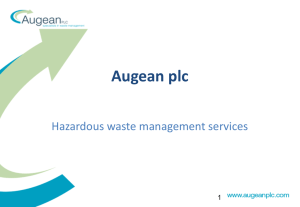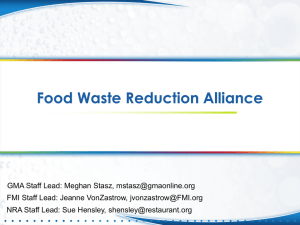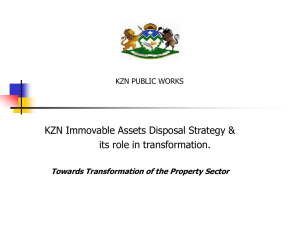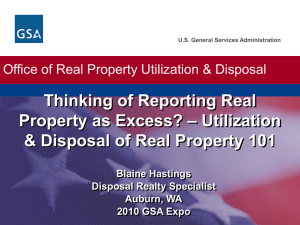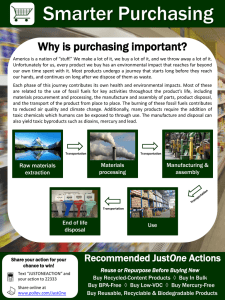Application form for a permit to dispose of vessels at sea
advertisement
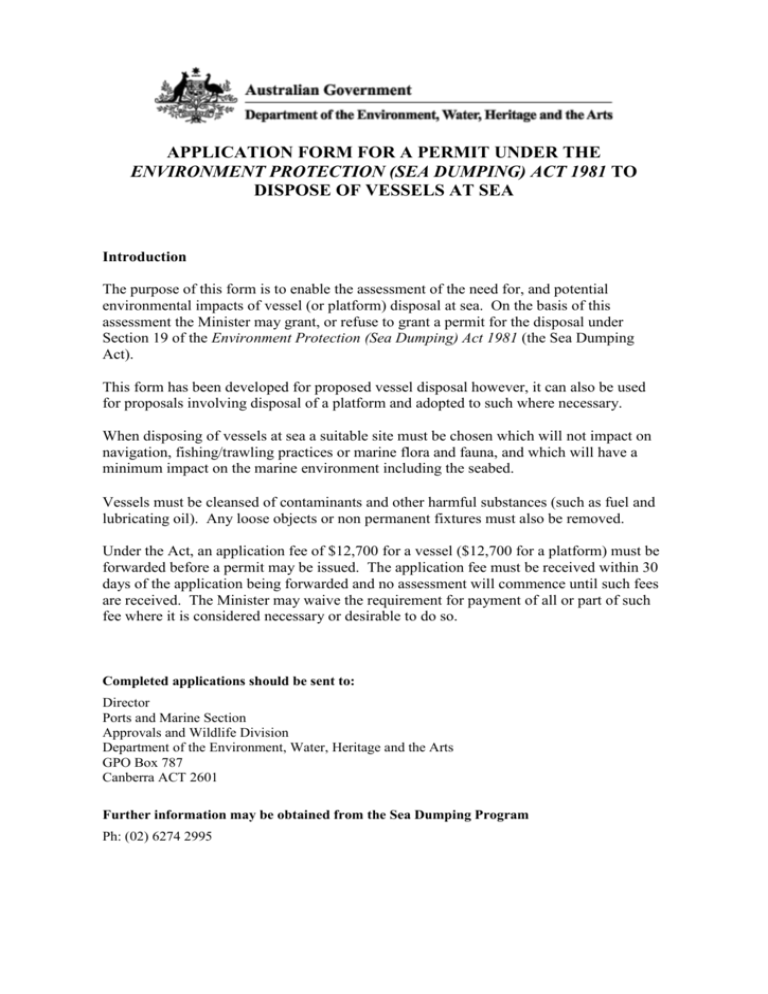
APPLICATION FORM FOR A PERMIT UNDER THE ENVIRONMENT PROTECTION (SEA DUMPING) ACT 1981 TO DISPOSE OF VESSELS AT SEA Introduction The purpose of this form is to enable the assessment of the need for, and potential environmental impacts of vessel (or platform) disposal at sea. On the basis of this assessment the Minister may grant, or refuse to grant a permit for the disposal under Section 19 of the Environment Protection (Sea Dumping) Act 1981 (the Sea Dumping Act). This form has been developed for proposed vessel disposal however, it can also be used for proposals involving disposal of a platform and adopted to such where necessary. When disposing of vessels at sea a suitable site must be chosen which will not impact on navigation, fishing/trawling practices or marine flora and fauna, and which will have a minimum impact on the marine environment including the seabed. Vessels must be cleansed of contaminants and other harmful substances (such as fuel and lubricating oil). Any loose objects or non permanent fixtures must also be removed. Under the Act, an application fee of $12,700 for a vessel ($12,700 for a platform) must be forwarded before a permit may be issued. The application fee must be received within 30 days of the application being forwarded and no assessment will commence until such fees are received. The Minister may waive the requirement for payment of all or part of such fee where it is considered necessary or desirable to do so. Completed applications should be sent to: Director Ports and Marine Section Approvals and Wildlife Division Department of the Environment, Water, Heritage and the Arts GPO Box 787 Canberra ACT 2601 Further information may be obtained from the Sea Dumping Program Ph: (02) 6274 2995 PART I – SUMMARY Name of applicant: Type of vessel requiring disposal: Location of disposal site: Dates of proposed disposal operations: Permit required by: Quantity of material to be disposed: Length of permit applied for in this application: Details of previous permits applied for (include dates, quantity and whether granted/refused): PART II - APPLICANT 1.0 Identity of applicant Name: Address: Postal address (if different): Contact person: Phone: Fax: Email: 2.0 Identity of the owner of the material to be disposed at sea (if different to 1.0) Name: Address: Postal address (if different): Phone: Email: Fax: PART III – DESCRIPTION OF VESSEL TO BE DUMPED 3.0 Description and assessment of vessels proposed for disposal Type: Name and/or number: Country of registration: Location where vessel can be inspected: History of use: 3.1 Provide a comprehensive description of the vessel including: its dimensions, age, composition, state, stability, estimated weight in air; and any types, amounts and relative hazards of contaminants including oils and paints which will remain on or within the vessel. Characterisation of waste materials by biological or chemical testing is not required if pollution prevention and best environmental practices have been implemented. PART IV – WASTE MANAGEMENT 4.0 Waste management options Applications to dispose of vessels at sea must demonstrate that consideration has been given to the following hierarchy of waste management options (which implies an order of increasing environmental impact). This includes taking into account the potential hazard of contaminants and the potential impact of the vessel on the environment. Re-use of all or some vessel components; Off-site recycling; Destruction of hazardous constituents; Treatment to reduce or remove the hazardous constituents; Disposal on land of all or some vessel components; and Disposal into sea of all or some vessel components. In referring to the above hierarchy, demonstrate that the following considerations have been taken into account: 5.0 planning including engineering/safety, economic and environmental analyses; cleaning of the vessel and its components; and site clearance. Pollution prevention and environmental best practice Applications to dispose vessels at sea must provide a pollution prevention and environmental best practice plan. The purpose here is to ensure that contaminants or other material capable of creating floating debris contributing to pollution of the marine environment and to fishing and navigational hazards have been removed to the maximum practicable extent prior to disposal at sea. At a minimum, the plan should cover: the potential sources, types, amounts and relative potential hazards and toxicity of contaminants on board (for example, hydrocarbons, PCBs, stocks of industrial or commercial chemicals) or other wastes that may pose an adverse risk to the marine environment; prevention of release of pollutants that could have adverse effects on the marine environment; removal of equipment containing liquid PCBs as a priority; the removal of contaminants, potentially hazardous constituents and liquid materials remaining in tanks or piping and on surfaces (including fuels, oils and antifoulant paints); removal of drummed, tanked, or canned liquids or gaseous materials from the vessel for disposal on land; removal of floating materials (including plastics) that could adversely impact safety, human health, or the ecological or aesthetic value of the marine environment; the cleaning of tanks, pipes and structures in an environmentally sound manner (including the wastewater containment); and chemical characterization of certain areas of a vessel (such as tanks) after cleaning, to confirm that the vessel has been cleaned to the maximum practicable extent. The above plans should take into account environmental impacts, technical and economic feasibility and worker safety. PART V - DESCRIPTION OF DISPOSAL SITE AND PROCEDURES 6.0 Carrier of Material 6.1 Name and port of registration of vessel to be used for sea disposal 6.2 Owner of vessel Name: Address: Postal address (if different): Phone: Fax: Email: 6.3 Person to be in charge of disposal operation 7.0 Method and procedure of disposal Describe proposed method of disposal at sea and planning details including: installation of flooding mechanisms; towing to site (wet tow/dry tow); disconnection from transport; rate, speed and heading of dumping; engineering/safety standards and person responsible for implementing such standards; contingency measures; assurance that vessel will sink and that significant fragments will not be dispersed; prevention of movement of the sunken vessel; steps taken to confirm position on the seabed after sinking the vessel; frequency of disposal and quantities per disposal; and for a platform provide details on method (such as abandonment, toppling or removal to a disposal site). 8.0 Description of Proposed Disposal Site 8.1 Location of site Attach a suitably scaled map of the proposed disposal site (the relevant sector from an AusMap), including a clear grid reference, showing bathymetric contours, the boundaries of the site and distance from land. Care should be taken to specify the coordinate system (WGS84 preferred over AGD66) and units used; eg. degrees, minutes, decimals of minutes or degrees, minutes, seconds. Does this site differ from the site used under previous permits? If so, relationship to previous site is to be indicated clearly on the map. 8.2 Position fixing Describe method to be used in positioning the dumping vessel. 8.3 Depth of Water depth of water from seabed to surface water at Lowest Astronomical Tide (LAT); and depth of water from highest point of the vessel to be sunk to surface water at LAT. 8.4 Indicate whether the proposed disposal site is subject to ‘Marine Park’ or other zoning which may have a bearing on its intended use. Describe any sensitive areas in the vicinity of the proposed site. 8.5 Provide information on the physical and other relevant characteristics of the disposal site. Include: sea-bed topography; sediment characteristics; biological characteristics; and other relevant information. 8.6 Reasons for the selection of the site. 8.7 Describe the history of the site if previously used for sea disposal. Describe intended program for collecting reference data on site characteristics to enable the monitoring of the consequences of the disposal operation should monitoring be required. PART VI - IMPACT HYPOTHESIS 9.0 Projected Impact of Disposal Describe the projected physical, chemical and biological impacts on the dump site and surrounding areas. Predict the impact of the disposal, based on what is being dumped, when disposal is taking place and disposal method; Delineate the area of sea bed that will be substantially impacted (the zone of impact); Assess the physical and ecological effects of the dumping activity, including impact on existing and adjacent habitats and biota; Predict fate of vessel after dumping; and Assess possible effects on other users of the area. The assessment should demonstrate that, with the implementation of pollution prevention and environmental best practices, any impacts will be minimal. Describe any intended investigations or studies of the possible impacts on the environment of the proposed action. PART VII – NATIONAL ENVIRONMENTAL SIGNIFICANCE 10.0 Referring Actions Under the EPBC Act The Environment Protection and Biodiversity Conservation Act 1999 (the EPBC Act) requires Commonwealth assessment and approval for any action that will have, or is likely to have a significant impact on a matter of national environmental significance. For a detailed discussion of assessment under the EPBC Act and how it interacts with the Sea Dumping Act refer to Section 1.3.2 of the National Ocean Disposal Guidelines for Dredged Materials. Where an action includes only those activities for which approval is required under the Sea Dumping Act, the applicant is not required to separately refer that action under the EPBC Act. If a referral is required, this will be done by the determining authority as part of the assessment of the permit application. The proponent will need to refer the proposal for a separate assessment and approval under the EPBC Act where the action also includes activities not covered by the Sea Dumping Act which may significantly impact on matters of national environmental significance. To ensure efficient co-ordination of the assessment process, it is important that the determining authority is aware of any referrals the proponent has made under the EPBC Act. As such, it is advisable that proponents discuss proposed actions with Environment Australia and answer the following questions: 10.1 Has the proposed action been referred to the Commonwealth Environment Minister under the EPBC Act? Yes No 10.2 Has a decision on this proposed action been reached? Yes No If ‘Yes’, please provide details of the decision. PART VIII - CONSULTATION 11.0 Consultation with advisory bodies Please consult with the Sea Dumping Program for advice on relevant stakeholders within your region and the method of consultation required. List the organisation or interests that you have consulted with on the proposed sea disposal activity. Attach the record of consultation to this application.

